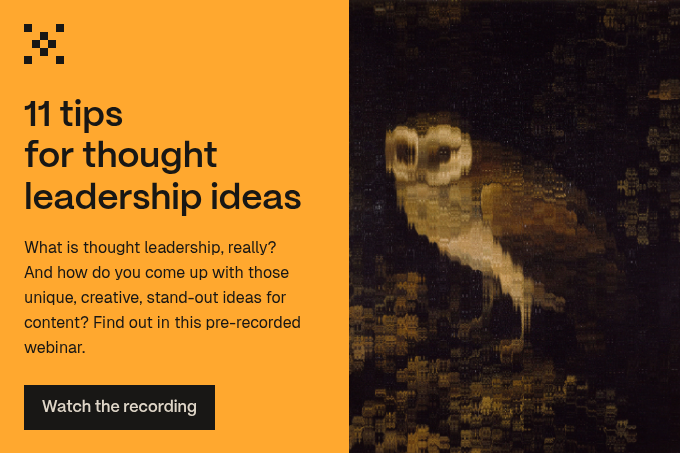According to The Corporate Executive Board, 77 percent of B2B buyers won’t even speak to a salesperson on the phone before they have conducted some research. What’s more, over half of prospects want to see how your product works on their first call with you. Now more than ever, buyers want to take control of the sales cycle.
They want facts. And they only want to work with brands they trust. When these things are missing, it causes friction and slows the process to a crawl. So, as an effective seller, how can you support buyers in their quest for knowledge?
By providing thought-provoking content throughout the entire sales cycle, you can inform your potential buyer, build trust, establish credibility and develop relationships.
What causes friction in the sales cycle and why?
Several things might cause friction in the sales cycle (no matter what you sell). Let’s explore these further.
- More information is needed. It’s simple. Your prospects have no reason to trust you or your business without enough evidence. A lack of information will increase the perceived risk associated with your brand and make it harder for prospects to evaluate their options.
- Buying is tiring and time-consuming. Your buyers are busy, important decision-makers. They have to do their day-to-day jobs on top of choosing new tools or services for the business. Plus, you’re likely not the only vendor they are talking to, so they may be sales-pitch fatigued. Keep the process straightforward and intuitive to prove that you value their time (and ensure they don’t lose interest).
- Poor communication. MarketingSherpa found that 79 percent of marketing leads never convert into sales, mostly caused by a lack of lead nurturing. Regular, tailored and relevant communication is critical to converting customers. This is where thought leadership content can work in your favour.
- Lack of USP clarity or alignment with the client’s needs. Whatever service or tool you’re offering, know that there are tons of others just like yours on the market. Ensure your USP is evident — and always align it to your prospect’s pain points. That is how you demonstrate that your offering is valuable.
Five ways thought leadership content reduces friction in the sales cycle
When we talk about thought leadership at Articulate, we’re referring to high-value content that contributes to relevant discussions, shares expertise and challenges the status quo. It offers real value to readers and shows potential buyers you are a serious player in their industry.
So, let’s explore how and why this kind of content can reduce friction in the sales cycle.
- It promotes credibility and trust. Content that discusses relevant industry topics, offers expert opinions and shares insight is crucial. It will help boost your SEO performance (and increase discoverability at the Awareness stage of your buyers’ journey) and ensure your prospects know you are an authoritative and reliable source. Remember, you want to build long-term business relationships, so trust is vital.
- To educate and add value. A Forbes study found that 74 percent of buyers chose the first company in their line-up of potential providers to add value. Sharing industry-relevant content with potential buyers at the start of their journey is a great way to start a conversation, get them thinking and keep your brand at the forefront of their minds.
- Show, don’t tell: the value of social proof. According to a Heinz Marketing report, 92 percent of B2B buyers are more likely to purchase after reading a trusted review. So, include testimonials and quotes in your content or even link to review sites. Include a review or two in your emails to prospects, to build your credibility.
- Answer questions and address pain points. Use your content as a tool to answer all the questions your potential buyers might have before they need to ask you. Showcase that you understand exactly what their individual or industry pain points are and give them clear examples of how your tool or service can support them.
- Introduce a new and human perspective. Creating thought leadership content is an excellent way for brands to share their viewpoint. It’s your chance to stand out from the crowd and align your brand’s values with your audience’s. Whatever the content, don’t be afraid to show your human side. Be relatable and evoke emotion. That’s how you build a connection.
The role of marketing content in the buyer journey
Every stage of the buyer’s journey will need some content. Each piece of content will serve a different purpose depending on how far through the journey your prospect is. Sales needs to work hand-in-hand with marketing to get it right.
Let’s explore the stages of the buyer journey and the type of content you should share at each stage.
1. Awareness
A ProfitWell study shows that 47 percent of buyers view 3-5 pieces of content before they talk with a sales rep. Thought-provoking content matters to your buyers before they’ve even decided to speak with you. Build a content marketing strategy that prioritises SEO, outlines potential problems and solutions and educates prospects who might not know what they are looking for.
Types of content to consider: informative blog posts, regular social media posts and video content. Consider adding a call-to-action to a newsletter or gated content. Marketing will be creating this content, but sales reps should keep up-to-date on what’s available in case a relevant topic comes up in conversation.
2. Consideration
At this stage, your prospect knows they have a problem and need a solution. It’s time to differentiate your product or service from your competitors. Use content to address specific needs and help them make more informed decisions.
Types of content to consider: product or service comparisons, long-form content (guides or eBooks) and testimonials. Send a series of targeted email comms that drip-feed this content to prospects. You could do this by setting up a marketing automation or sales reps could send content directly. Or, both!
3. Decision
Your prospect has all the information they need to make their decision. Now, you must reassure them they’ve made the right choice and get them over the line.
Types of content to consider: customer success stories, details and specifications of products or services, policies (including guarantees and warranties) and FAQs. Sales reps need to be driving trust at every touchpoint, and this content is proven to persuade.
4. Purchase
Congratulations! You have a new customer. But your content journey doesn’t stop here. You’ll need to help your new customer take the next steps by providing everything they need to maximise their success using your product or service.
Types of content to consider: confirmation emails, product or service guides and tutorials, and a series of ‘welcome’ emails featuring support and information. Sales is responsible for handing this new customer over to the customer service team and co-ordinating the flow of content.
5. Post-purchase
Did you know that content marketing can increase customer lifetime value by up to 70 percent? Once the purchase is complete, it’s all about customer satisfaction. You must turn your customers into loyal advocates to reap the rewards. Thought-provoking content will help.
Types of content to consider: articles that include tips and best practices, tailored loyalty or reward schemes, how-to videos and any news that could impact their experience. Customer services could work with marketing to build this ‘customer delight’ type of content.
6. Advocacy
According to Dale Carnegie, 91 percent of customers say they'd give referrals, but only 11 percent of salespeople ask for them. If you don’t ask happy customers for referrals, you are sitting on an untapped lead generation machine. But it’s a two-way street. Ensure your customers feel valued and consider providing something in return.
Types of content to consider: It’s time to create content with your advocates, such as guest blog posts, podcasts, case studies or webinars. You may also want to design an advocacy or referral program that rewards loyal customers and shares exclusive tips and insights. Marketers should discuss with Sales and Customer service teams which customers would be happy to engage in this kind of content creation process.
Provoke thought, build trust, win sales
At Articulate, we always share our thought leadership content throughout the sales cycle. Last year, we saw a tremendous success rate after developing a health-focused campaign and sharing tailored, relevant content with our prospects. This resulted in an increase of 33.6 percent of Marketing Qualified Leads (MQLs) that converted to Sales Qualified Leads (SQLs), as well as higher email click-through rates and improved average conversions.
Creating content that is meaningful, valuable and bespoke pays off. If you’re not already creating thought leadership content, now is the time to start. And if you are, it’s time to maximise your selling success by improving how and how often you share your valuable content with potential buyers.
To learn more about creating thought-provoking content and using it for sales success, you can speak to a member of the Articulate sales team, here.
.jpg?width=100&height=100&name=1694622801428%20(1).jpg)
.jpg?width=64&height=64&name=1694622801428%20(1).jpg) Posted by
Sian Cooper
Posted by
Sian Cooper
.webp?width=1600&height=800&name=Frame%201%20(9).webp)





